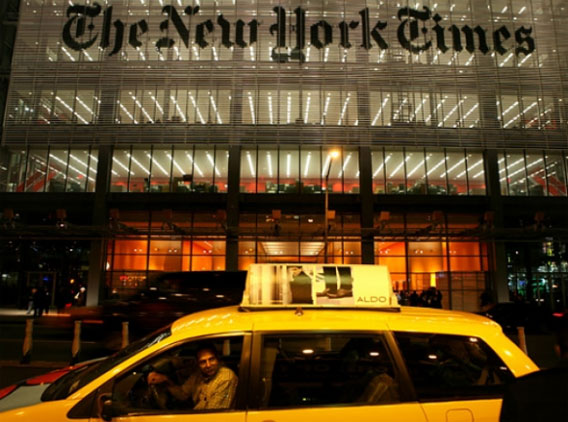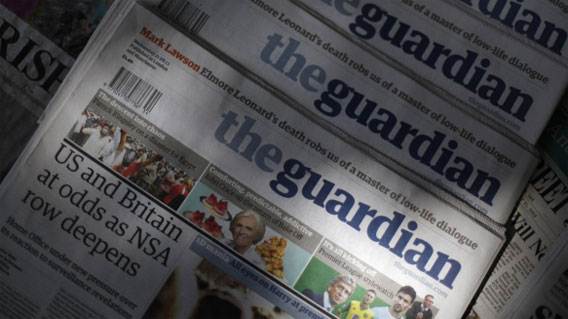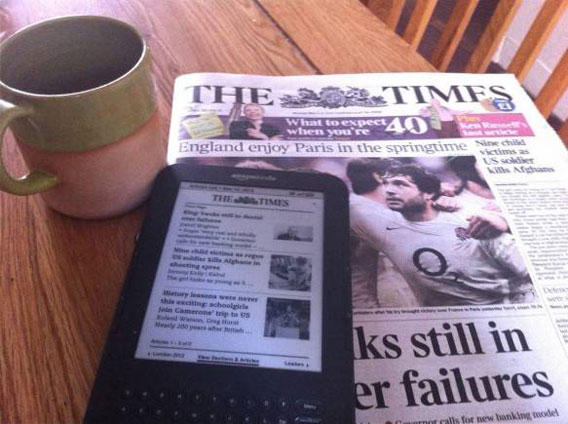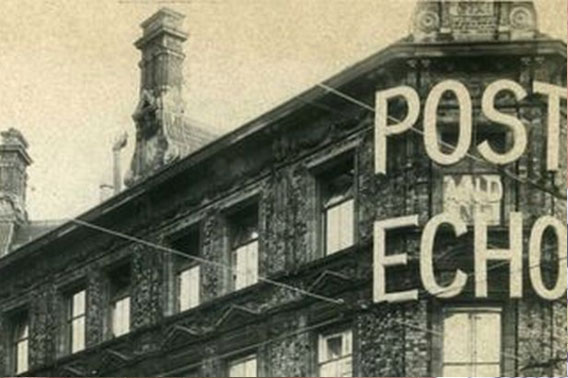Print Is Dying: World’s 5 Poorest Papers
Don’t be surprised if your younger son asks you, “Dad, what’s a newspaper?” You may as well tell him, “It’s a sign of dad getting older” and that your son was born to a digital age. As much as some of us miss the breakfast table with the newspaper, it’s time to admit that the morning eggs, bacon and orange juice is only a reminder of a slow-moving paper-based news media and that your blood pressure needs a check-up! Today’s news happens so fast and updates are by the minute for digital readers and on the Internet. The real question is, is this good or bad news?
 Our newspapers – once the dominant and seemingly unassailable medium of relating current affairs to the public – appear, according to popular opinion, to either to be on their last legs, or in the midst of their deepest crisis to date. The broadsheet was once a fixture of everyday life, and an integral part of the traditional Sunday morning routine; but these days, we’re more likely to log on to Twitter for the very latest news in the morning than to nip to the corner store for the potentially outdated paper.
Our newspapers – once the dominant and seemingly unassailable medium of relating current affairs to the public – appear, according to popular opinion, to either to be on their last legs, or in the midst of their deepest crisis to date. The broadsheet was once a fixture of everyday life, and an integral part of the traditional Sunday morning routine; but these days, we’re more likely to log on to Twitter for the very latest news in the morning than to nip to the corner store for the potentially outdated paper.
Proportional to the rise of online, mobile communications, the newspaper industry has seen a decline in revenue and readership, and – in many cases – a crisis over their role and place in society. Mobile devices have encouraged the evolution of new writing styles and more visual content, causing a major overhaul in the traditional style of broadsheet reporting, with many publications attempting to reinvent or diversify their image to keep up with the rapidly evolving online media. The advertising revenue, which newspapers relied on to cover their overheads, seemed to be a fountain of gold in the 1970s and 1980s but with the internet came new opportunities: classified ads moved to Craigslist, large scale advertisers switched to the cheaper digital ad format to promote their brands and newspapers were soon forced into the red.
The costs of printing and distributing daily publications – which now have a much lower circulation rate than in previous decades – has led many regional papers to scale back their print editions, succumbing to the insurmountable predominance of their digital rivals. some high profile public scandals in the print media world have exacerbated the decline of the newspaper, like the UK’s infamous phone hacking incident involving a number of newspapers under Rupert Murdoch’s News Corporation: Blips like this left many of the remaining loyal newspaper readers questioning the relevance and sustainability of the medium in our digital age.
 It’s not all doom and gloom for the printing press though, or at least not yet. Some papers have come out fighting with sales of print editions of daily newspapers remaining particularly strong in Latin America, as well as in the Middle East. Paradoxically, while the print industry is seeing a sharp decline in revenue and readership the journalism industry appears to be booming: in 2009, at a time when many questioned the fate of even the most esteemed newspapers featured on our list, Columbia University saw applications for its journalism programme increase 40% on the previous year.
It’s not all doom and gloom for the printing press though, or at least not yet. Some papers have come out fighting with sales of print editions of daily newspapers remaining particularly strong in Latin America, as well as in the Middle East. Paradoxically, while the print industry is seeing a sharp decline in revenue and readership the journalism industry appears to be booming: in 2009, at a time when many questioned the fate of even the most esteemed newspapers featured on our list, Columbia University saw applications for its journalism programme increase 40% on the previous year.
Many papers, such as the Financial Times and the Washington Post have also managed to turn a profit in these dark days, with Amazon founder Jeff Bezos this year buying the Washington Post for $250 million USD. Many other publications including The Times (UK) and The New York Times have erected paywalls for their online website and digital editions in an attempt to recuperate losses from declining print sales. For many however, this won’t be enough. A devastating number of high-profile English-language newspapers are endangered, debating their long-term future and strategy. In light of this, we take a look at the top five newspapers that are losing the battle with digital media according to significant losses they’ve reported in recent years and concerns voiced by the institutions themselves; read on to find out which five famous print media institutions might not exist as we know them in five years time.
5. The New York Times: $24 million Loss

The New York Times prides itself on being one of, if not the best newspapers in the world, but like fellow broadsheets featured here, it has struggled to score profit in the digital age. So famous is the paper’s financial fall from grace that it was even the subject of 2010 documentary ‘Page One: Inside the New York Times’ featuring the paper’s own reporters questioning the future of their employer. Job losses and salary cuts have been widespread across the New York Times’ staff, and the paper has been making heavily pushing their online and mobile subscriptions.
The pay-for subscription, launched in 2011, allows browsing users limited access before requiring them to subscribe to the service. In a report at the end of October this year, The New York Times Company s a whole reported’a loss of $24 million in the third quarter, which included an $18.9 million loss from discontinued operations related to New England Media Group and a $2.5 million income tax expense from the sale.’ That’s a pretty hefty loss by all accounts. It’s not all bad news though; some silver linings were reported, including the fact that paid online subscriptions reportedly jumped by 28% from the same quarter last year.
4. The Guardian: $71 million Loss

The Guardian, a London-based liberal newspaper is a surprising entry on our list given its prestige as a high-quality newspaper and its global reach through its network of reporters. Founded in Manchester in 1821 the newspaper has received unparalleled attention in recent years for its investigations around both the phone hacking scandal in the UK, it’s collaboration with Wikileaks, and most recently its exposure – along with The New York Times – of the NSA documents from Edward Snowdon. Investigative journalism of this calibre certainly does attract attention, with the paper’s sales up in the last quarter compared to last year: but the problem for the Guardian, it appears, is its money-making ethos.
The website is entirely open source with the iPad and mobile apps only recently requiring a download fee. In 2011 the paper reported a loss in the region of $71 million. In 2013 the figure did tip back into the black as a result of a 29% increase in digital revenue. The future of the Guardian however remains particularly uncertain as even the paper’s editor, Alan Rusbridger, voiced his concerns for the newspaper’s durability in an interview with The New Yorker. It would seem that in spite of a recent financial turn around, as well as critical praise, these are very much still uncertain times for the Guardian.
3. The Times (UK) : $47 million Loss

The Times is one of the world’s most revered newspapers, with the variety and high quality of journalism offered at the London-based newspaper setting it apart from its rivals. What also distinguishes it from its rivals, most notably The Daily Telegraph, is its inability to turn a profit in recent years. Since 2010 the paper has created a strict paywall preventing access to the paper’s website without a paid subscription. The Times and their parent company News Corp have been criticised for creating an elitist system around their website but the paper itself maintains that it’s simply aiming to generate a more loyal readership.
Online subscriptions for the newspaper are in the region of 140,000 which – considering the population of London alone is around 8.1 million – is relatively tiny. While rival The Telegraph takes in around £50 million in profit annually, The Times has had to rely on Murdoch and Co. to bail them out, losing $47 million USD in the year ending July 2013. The paper’s reputation has remained relatively unscathed in light of the phone hacking scandal (the paper is under the reign of Rupert Murdoch’s News Corp) but the profits, however, have not.
2. Liverpool Post and Business Daily: 20,000 Readers Lost

The first official victim of the ‘print is dead’ pandemic on our list, another UK paper takes the number two spot. Te Liverpool Post is proof that while papers like The New York Times may be seeing a return to profit, for many small and local papers the future is still highly uncertain. This week the paper’s parent company, Trinity Mirror, announced that it was to cease production of the Liverpool Post as well as the e-editions of Business Daily, instead increasing investment on their other newspaper, The Liverpool Echo. The Liverpool Post, which was founded in 1855, will issue its last edition on the 19th of December this year – the same day Business Daily will close. The paper had been in trouble for some time however: originally a daily publication, the Liverpool Post was scaled back to a weekly paper in 2011. Trinity Mirror has maintained that the company’s focus on sister publication, the Liverpool Echo, will in the long run benefit journalism in the British city, creating more jobs in the process. If the above examples are anything to go by however, we would advise only very cautious optimism in this regard.
1. The Tribune Company: From $8.2 billion to Bankruptcy

If ever there was an opportunity to learn from past mistakes in news groups, then the sale and subsequent sudden decline of the Chicago-based Tribune Company is surely it. The company, who oversees papers including the Los Angeles Times, The Chicago Tribune and The Baltimore Sun, as well as numerous television stations, was sold to entrepreneur Sam Zell in 2007 for a tidy $8.2 billion USD. This however was the beginning of the end, with the group filing for bankruptcy by December 2008.
Since then the company has attempted to turn a profit by restructuring, refinancing, selling off assets and redundancies – all to no effect. Last month, the company reported there would be 700 job losses in the company, citing a decline in ad revenue as the reason for further cut backs. At the same time the price of print editions has risen, with the price of the Los Angeles Times increasing by 50% in 2009. While papers like the Guardian and The Times may be able to hold onto their heritage and prestige, the Tribune Company has been severely damaged as a result of these tumultuous years and, evidently, the storm is far from over.

© 2013 Copyright ShootTheCenterfold.com. All rights reserved.



















